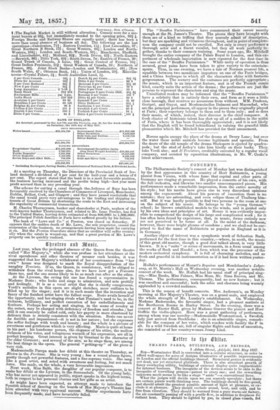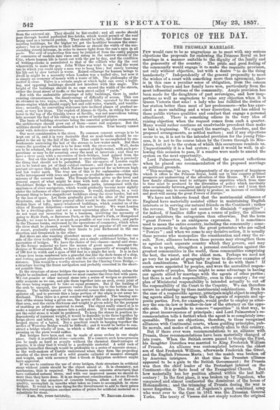tattr In Iljt Ebitsr, THAMES PARKS, BUILDINGS, AND BRIDGES.
1 Adam Street, Adelphi, 1811; May 1887. Sea—Westminster Hall is converted into a cellular structure, in order to afford wall-space for acres of designs illustrative of possible improvements in London and the official buildings thereof. Structural genius is evidently not dead, nor yet structural platitude. There is also abundant growth of fancy overlaying utility, buildings of external display quite impracticable for internal busineas. The incognito of the devices seems to be akin to the incognito of travelling princes—patent to every one; and the rewarding unknown merit seems to be like a stage " aside "—a conventional farce. What the judges will decide upon we can scarcely speculate ; but there are certain points worth thinking over. The buildings should be fire-proof, and should admit the greatest possible amount of light at pleasure, or exclude it at pleasure. They should exclude sound, heat, and cold, and be free from vibration. They should be warmed from a pure warm-air factory, the air constantly passing off with a gentle flow, in addition to fireplaces for radiant heat. They should be lighted by gas, in closed glass vessels, fed
from the external air. They should be flat-roofed; and all smoke should pass through heated perforated fire-bricks, which would permit of the roof being used as a terraced garden. They should be lofty, far loftier than any existing buildings, for the higher we get the healthier becomes the atmosphere; but in proportion to their loftiness so should the width of the sur rounding streets increase, in order to insure light from the sun's rays in all
parts. The evil of neglecting this maybe judged of from the costly palaces of commerce of modem date risen ad rising in the narrow streets of the
City, where human life is burnt out with the gas by day, and the condition of writing-clerks is assimilated to that of the colliers who dig the coal wherewith to make the gee. John Wilkes was wont to say that the worst use to which you could apply a man was to hang bun; but surely burning his life out by slow torture is worse. Raised cellarage for human beings to dwell in might be a necessity when London was a walled city, but now it is simply an economy of money with a waste of life. The philosophy of the matter is clear. There is a certain angle at which light can enter a building, and opposing buildings should not interfere with this angle. The height of the buildings should in no ease exceed the width of the streets, either the front street of traffic or the back street called "yards." But with the undeniable advantage of lofty buildings, there is, under existing circumstances, the disadvantage of difficulty of access. This can be obviated in two ways,—first, by mechanical lifts, operated by the same
steam-engine which should supply Lot and cold water, warmth, and ventilation ; secondly, by converting staircases into inclined planes of gradual ascent, or very low steps. The exploit of Alonzo de Oj a, in riding his war
horse to the top of the Glialda tower at Seville, was not marvellous taking into account the fact of his riding up a series of inclined planes. The basis of building structure being the essential principles enumerated, the architecture should grow out of them—cause and sequence. But the utilities should not be subordinated to the ornaments. True beauty cannot exist with defective structure.
Our next consideration is the river. By common consent sewage is to be kept out of it, and it is very, desirable that no mud-banks should be exposed to the air by the fall of the tide. This could be accomplished by em
bankments narrowing the bed of the stream to low-water mark. But then
comes the question of what is to be done with the river-craft. Well, docks are to be retained, the gates only to be opened at high-water, with such pre
parations as may be for scouring away the mud at intervals and thus we have a river quay with a succession of dock-bridges laud gained from the river. But on this land it is proposed to erect buildings. This is precisely the thing that should not be permitted. The air-spaces of London ought not to be bated one jot of their cubical contents ; and there is no more im portant air-space than that which Nature has preserved for us between high and low water mark. The true use of this is for esplanades—rides and walks interspersed with trees and gardens on available spots—absorbing the miasma of the covered banks. The Temple Garden gives us the level and general aspect of what might be done with both sides of the river from Blackfriars Bridge to Westminster—Thames parks, interspersed with the appliances of river navigation, which would gradually become more sightly under the influence of other improvements. It would, doubtless, be a very pleasant thing to have magnificent buildings along the river border, but not by the lose of space. Let them gradually grow on the sites of the present structures and a far better general effect would be the result than the un
broken lilies of lofty, many-windowed buildings, which remind us of the cities of Russian despotism—vastness but not beauty. We want London to be a dwelling-place and not a mere sojourning place of business. We do not want our recreation to be a business, involving the necessity of
going to Hyde Park, or Battersea Park, or the Regent's Park, or Hampstead Heath ; we want to have it as much as possible at our own doors ; and parks by the Thames banks, enlivened by the operations of commerce, which when the river shall be cleaned, would become the most popular of all our places of resort, gradually extending their limits to join Richmond in the one direction and Greenwich in the other.
But there are also wanting abundant means of communication from one side of the river to the other. We need, not a single additional bridge, but a succession of bridges. We have the choice of two classes—metal and stone. In the former material we have the means of great spans. Amongst the designs at Westminster Hall, we have a bridge, apparently of wrought iron, of 100 feet in width and a span of 926 feet in a single fiat arch. It is in fact a huge iron beam cambered into a graceful riselike the deck-beam of a ship, and resting against abutments which add the arch resistance to the beam re sistance. This would be a worthy structure for the Charing Cross Bridge,— a structure keying the freest navigation and probably executed in the shortest possible time. In the structure of stone bridges the span is necessarily limited, unless the height be unlimited; and therefore we must cumber the river-bed with piers. We cut granite or other natural stone into a series of wedges as geometri
cally accurate as we can, and pile them together jute an arch, every joint of the stone being supposed to take an equal pressure. But if the loading of
the arch be unequal, the pressure vanes from the top to the bottom of the
stones. The brittle nature of the material causes the edges in this ease to splinter off, and to prevent this a largo portion of the edges is out away be forehand. Thus there is agreat surplus weight applied. The bearing sur
face of the stones being a given one, the power of the arch is proportioned to that area, and the extra thickness and weight is given solely for the purpose of enabling an inferior material to resist. The object really aimed at is to make a number of wedge-stones into a solid stone. If it were practicable to get the solid stone it would be preferred. To keep the stones in position in dependently of insistent weight, it would be desirable to tie them together by hoops above and below, in which case the arch would become solid like the hooped staves of a barrel. But a practical result hi hooping together the arches of Waterloo Bridge would be difficult ; and it would be better to construct a bridge wholly of iron, in which a tithe of the weight of material pressing on the piers would suffice. But bridges have been and can be made of atone arches in one single piece. Only it is artificial stone—concrete. If a concrete arch homogeneous can be made aa hard as granite without the chemical disadvantages of granite, it is clear that it would be a preferable material. A solid rock of granite tunnelled through would be preferable to a series of separate stones ; as the well-makers of Castile understand when they form the projecting mouths of the draw-well of a solid granite cylinder of massive strength and weight, and with accuracy that a Greek or Egyptian architect might have approved. If we are to continue the use of stone bridges, their structure in artificial stone without joints should be the object mined at. It is chemistry, not mechanism that is required. The Romans made concrete structures that have outlasted natural stone, and with our improved means we should do more than they have done. It is an important consideration ; for our French neighbours in the structure of concrete bridges, albeit not of first-rate quality, accomplish in months what takes us years to accomplish in stone bridges. It would be a wise thing for the Government to add to their iwizce for structural composition another series of prizes for artificial materim1 as a substitute for stone.
I am, Sir, yours faithfully, W. Ban:Km ADAMS.



























 Previous page
Previous page